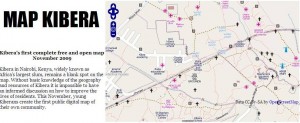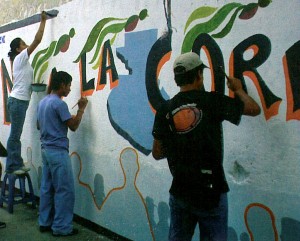The Technology Transparency Network (Disclosure: I am on the board of advisors) is a mapping project looking at about 40 case studies in developing countries that aim to promote transparency, accountability and civic engagement. Adding to the really good review of the first set of projects by David Sasaki, I would like to focus in this post on the aspect that many of the projects assessed are very local in nature. By this, they effectively empower citizens to take action locally to hold their leaders to account.
Local communities
The fact of operating mainly in a local environment provides some really nice advantages.
Let’s look at the Kibera Map. This project shows really well how local ownership by citizens could be used to hold local leaders accountable, for example through monitoring infrastructure or waste removal as David suggests. This kind of citizen monitoring can reduce corruption and ensure that allocated monies actually arrive where they should. It would be interesting to look more in depth at how basic services such as health, education or water are delivered to a community.
 I am not an expert in education, but from a users point of view I would be interested in comparing the amount of schools that exist in a certain neighborhood with other neighborhoods. Or in trying to match up the budget dedicated to these schools with what actually arrives (especially when we look at the corruption taking place in this sector as analysed in a recent TI report). This could be simply by using a picture of the school building, or of learning materials available contrasted with what should be there in terms of money, materials and teachers.
I am not an expert in education, but from a users point of view I would be interested in comparing the amount of schools that exist in a certain neighborhood with other neighborhoods. Or in trying to match up the budget dedicated to these schools with what actually arrives (especially when we look at the corruption taking place in this sector as analysed in a recent TI report). This could be simply by using a picture of the school building, or of learning materials available contrasted with what should be there in terms of money, materials and teachers.
I feel that the great thing about maps in this hyper-local context is that they really spark the imagination of what one could monitor, map and measure (The International Fund for Agricultural Development (IFAD) gives a nice overview of using participatory mapping for development in this publication). Sithi.org in Cambodia, a map-based visualization of human rights violations and related news in Cambodia, and Kubana.net in Zimbabwe are promising example for how various local or national stakeholders can collaborate.
Local accountability
But monitoring can also be applied to politicians and other public office holders. A great and straight forward idea is to do this by comparing what a politician promises, and what he delivers (good examples for this are the platforms Mumbai Votes and Praja). But I really like the idea of adopting a politician and blogging about what he does. It brings the relationship with your local politican to a personal level, away from public profiles and official party channels. It’s a simple action that can be done by every citizen and that increases accountability. The wiki page Adote um Vereador gathers these personal blogs in Brazil.
Guatemala Visible is an excellent project that allows for very concrete and timely limited political engagement by citizens beyond the major elections (which are indeed very important and well represented in the sample by the excellent projects of Vota Inteligente from Chile or the many national Ushahidi implementations). It sheds the light on the very important, but yet too often overseen processes of the instatement of government institutions and powerful public officials by the elected politicians.
As highlighted in the project idea of Ishki.com, “conversations among friends and family frequently turn into complaint circles with long lists of frustrations directed at the local and national governments, unresponsive banks, damaged roads, and corrupt officials”. Unfortunately the related complaint brockerage site is not online anymore.
But technology such as forums can serve these local needs very well, as seen in the community forum bringing residents together to protest against construction of a waste incinerator in Guangzhou, China.
The power of twitter lies in its networking function probably more so than in creating lasting platforms as the case study #InternetNecesario shows. Twitter and SMS distribution services could create hyper-local news pages connecting local media and investigative journalism with citizens needs and political engagement, a concept that is increasingly being implemented and gaining attention in developing countries. Two excellent examples are Frankfurt Gestalten in Germany, and London’s King’s Cross.
Accountability Chain
Overall, many of these local projects work because they are local. Outreach to citizens can be done with limited resources and a small amount of staff. But to become sustainable, they might need to grow beyond their initial audiences and stakeholders and try to find ways to involve and collaborate with all members of the accountability chain – local politicians, local administration, local businesses, local NGOs and the people living in these communities. By becoming more inclusive, they will be much more powerful to create lasting and sustainable good governance.
Transparency International has developed the National Integrity System Assessment approach, providing a framework to analyse both the extent and causes of corruption in a given country as well as the effectiveness of national anti-corruption efforts. The assessment is part of TI’s holistic concept to tackle corruption, making use of the concept of the National Integrity System – the principle institutions and actors that contribute to integrity, transparency and accountability in a society.
The future may very well lie in these action-orientated Local and “Hyper-local Integrity Systems” where citizens monitor and engage with their local environment, controlling institutions and holding their local administration accountable.
What are your views? Do you know of any other similar projects?
I am also cross-posting this post at Accountability 2.0, where you will find more discussions on similar issues.
















 Connect with us on Facebook
Connect with us on Facebook Follow us on Twitter
Follow us on Twitter